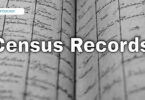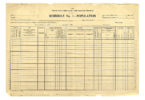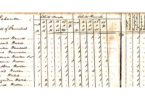The 1850 US federal census is a historically important one, as most genealogists of even a little experience know. If you are a total beginner, this census is a game-changer for your genealogy research. That is because it is the first one that recorded the names of every person in a household; previous censuses only recorded the names of the heads of households, along with the number of other residents of different age groups, and whether male or female. The 1850 census records every name, so no one gets lost to history. To many genealogists doing American genealogy, it is the first piece of documented proof or even knowledge, they have of an ancestor’s existence.
In addition to this historic change to the census, this census was also designed to be more accurate than previous ones. This is due to the fact that enumerators were, for the first time, given a set of printed instructions on how to conduct the census to take with them into the field. Comparisons to previous censuses have shown that the 1850 census was, indeed, more accurate than the previous ones, and the printed instructions the enumerators were given to bring with them is what researchers have accounted for this improved accuracy.
This was the seventh US census to be taken and was conducted beginning June 1, 1850, until December 31, 1850. The population for this census was determined to be approximately twenty-three million people, which was a thirty-five percent increase from the 1840 census. The total US population enumerated in the 1850 US census included 3.2 million slaves.
Questions asked of US citizens and residents on the 1850 US federal census include the following:
- Name
- Age (as of the date they were enumerated)
- Whether male or female
- Color
- Place of birth
- Occupation (only applicable to males over the age of fifteen)
- The value of any real estate owned
- Whether a person had been married in the previous year
- Whether a person was disabled (deaf, mute, insane, blind, or “idiotic”)
- Whether able to read or write (only applicable to those over the age of twenty)
- Whether a person attended school during the past year
- Whether a person was a pauper or a convict
Unlike later censuses, this one did not record the relationship of other household members to the head of the household. However, the other information provided, as well as the names of neighbors, can often reveal or at least hint at such relationships.
While free people were all recorded by name in the 1850 US federal census, slaves were not. They were recorded on a separate schedule, and listed by gender and their estimated age, along with the name of their owner. These can still be useful for those conducting African-American genealogical research in locating their ancestors, especially when combined with other available records. When other records are available, the 1850 census slave schedules can often be instrumental in identifying the location, age, gender, and owner of an ancestor, and placing an ancestor by name in that owner’s household.
African-American residents who were free were recorded by name, along with each person in their household, just like everyone else on the non-slave schedule, and using all of the same questions asked of everyone else.
Like the 1870 US census, there was a controversy with the taking of the 1850 US federal census. This one centered on the territory of Utah, which was not yet a state. A separate territorial census of Utah was taken in 1851, but census secretary Broughton Harris refused to certify the results of that census. His reasoning was that he believed Bringham Young, the founder of the Utah territory, conducted the census without Harris’s supervision or participation.
This dispute was instrumental in Harris’s decision to abandon his post and join other so-called “Runaway Officials of 1851” — Utah territorial officials who left their posts in protest of various goings on in the territory during that year. After the departure of Harris and other officials, relations between the US federal government and Utah officials and residents declined, eventually resulting in the Utah War.
Part of the difficulty in relations between the US federal government and Utah was that local government officials in the territory believed that having slaves there might hinder their request for statehood. At the time, some members of Congress did not want slavery to be a part of the western territories. The slave schedule for the 1850 US federal census shows only twenty-six slaves in the territory of Utah, and a note is included that all of them were being sent to California. However, later researchers estimate that there were about a hundred African-Americans in Utah at the time of the 1850 US federal census and that all of them were slaves.
In addition to the Utah controversy, the 1850 US federal census shows one more interesting bit of information about the United States at this time in history. This is that the territory of the United States had expanded greatly since the previous census. Texas had been admitted as a state, and Oregon had been made into a US territory. Parts of Mexico had also been incorporated into the United States. These new acquisitions accounted for an additional million square miles of land added to the nation.
The United States was becoming a legitimate world economic power by this time in history, thanks to the Industrial Revolution that was just beginning at the time of this census. The economic information on the 1850 US federal census includes a great amount of wealth in manufacturing, a lot of which went to exports to other countries. The United States was becoming competitive on an economic basis with Great Britain, France, Spain, the Netherlands, Germany, and other European powerhouses. This meant it was also finally becoming a nation that the world took seriously. The 1850 US federal census shows the United States was becoming the nation we know it to be today.
You can get all of the genealogical charts and forms I have discussed on this website.





Very enjoyable. Thank you.